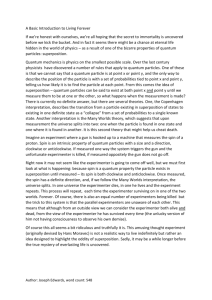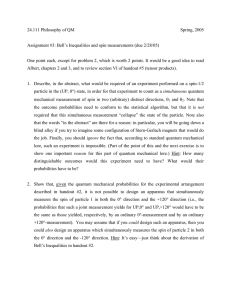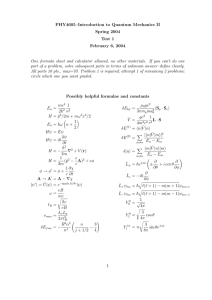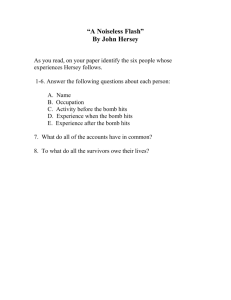Philosophy of QM 24.111 Eighth lecture, 23 February 2005
advertisement
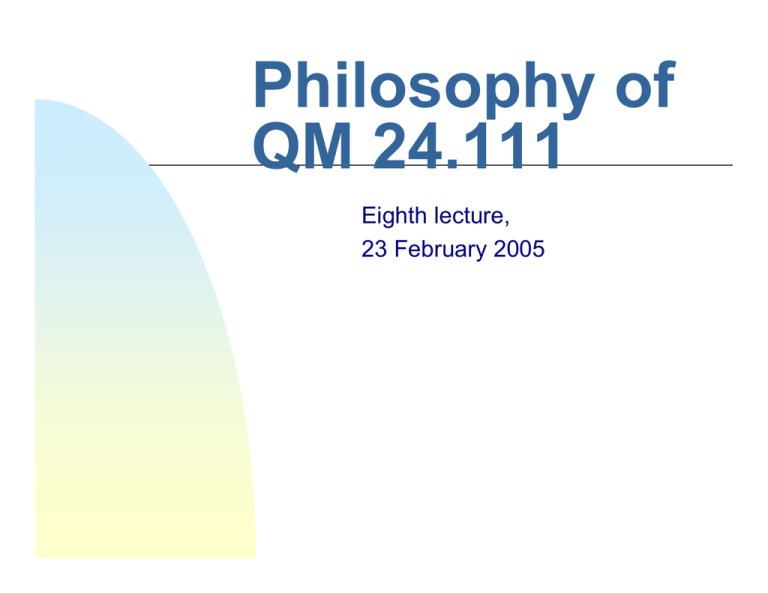
Philosophy of
QM 24.111
Eighth lecture,
23 February 2005
Strategy for analysis
1. Break the experimental situation up into steps.
2. At each step, look for easy cases.
3. Describe hard cases as linear combinations of easy cases.
4. Make use of the linearity of Schrödinger’s Equation to
“transfer” the analysis of the easy cases over to the hard cases: if
Φ Æ Φ’,
and
Ψ Æ Ψ’,
then
aΦ + bΨ Æ aΦ’ + bΨ’.
5. Make discreet use of the collapse postulate, as needed.
Spin measurements revisited
region R2
orientation 0°
UP
region R1
DOWN
region R3
Spin measurements revisited
FIRST CASE:
UP
DOWN
Initial state is | up, 0°> | in R1 >
Therefore final state must be | up, 0°> | in R2 >
Spin measurements revisited
SECOND CASE:
UP
DOWN
Initial state is | down, 0°> | in R1 >
Therefore final state must be | down, 0°> | in R3 >
Spin measurements revisited
THIRD CASE:
UP
DOWN
Initial state is | up, 90°> | in R1 >
= 1/√2 (| up, 0°> + | down, 0°> ) | in R1 >
= 1/√2 | up, 0°> | in R1 > + 1/√2 | down, 0°> | in R1 >
Therefore final pre-measurement state must be
1/√2 | up, 0°> | in R2 > + 1/√2 | down, 0°> | in R3 >
Spin measurements revisited
What the hell sort of state is that???
Never mind. It will quickly “collapse” into either
UP
DOWN
Initial state is | up, 90°> | in R1 >
= 1/√2 (| up, 0°> + | down, 0°> ) | in R1 >
= 1/√2 | up, 0°> | in R1 > + 1/√2 | down, 0°> | in R1 >
Spin measurements revisited
What the hell sort of state is that???
Never mind. It will quickly “collapse” into either
UP
DOWN
Initial state is | up, 90°> | in R1 >
= 1/√2 (| up, 0°> + | down, 0°> ) | in R1 >
= 1/√2 | up, 0°> | in R1 > + 1/√2 | down, 0°> | in R1 >
| up, 0°> | in R2 >
Prob = 1/2
Spin measurements revisited
What the hell sort of state is that???
Never mind. It will quickly “collapse” into either
or
UP
DOWN
Initial state is | up, 90°> | in R1 >
= 1/√2 (| up, 0°> + | down, 0°> ) | in R1 >
= 1/√2 | up, 0°> | in R1 > + 1/√2 | down, 0°> | in R1 >
| down, 0°> | in R3 >
Prob = 1/2
Coupled spin
measurements 1
orientation = 0°
UP
region R4
orientation = 0°
UP
region R1
region R2
DOWN
UP
DOWN
region R5
region R3
DOWN
orientation = 0°
Coupled spin
measurements 2
orientation = 0°
UP
FIRST CASE:
orientation = 0°
UP
DOWN
DOWN
UP
Initial state is | up, 0°> | in R1 >
Next state is | up, 0°> | in R2 >
Final state is | up, 0°> | in R4 >
DOWN
orientation = 0°
Coupled spin
measurements 3
orientation = 0°
UP
SECOND CASE:
orientation = 0°
UP
DOWN
DOWN
UP
Initial state is | down, 0°> | in R1 >
Next state is | down, 0°> | in R3 >
Final state is | down, 0°> | in R5 >
DOWN
orientation = 0°
Coupled spin
measurements 4
orientation = 0°
UP
THIRD CASE:
orientation = 0°
UP
DOWN
DOWN
UP
Initial state is | up, 90°> | in R1 >
= 1/√2 | up, 0°> | in R1 > + 1/√2 | down, 0°> | in R1 >
via Schrödinger
1/√2 | up, 0°> | in R2 > + 1/√2 | down, 0°> | in R3 >
DOWN
orientation = 0°
Coupled spin
measurements 5
orientation = 0°
UP
THIRD CASE:
orientation = 0°
UP
DOWN
DOWN
UP
Then:
1/√2 | up, 0°> | in R2 > + 1/√2 | down, 0°> | in R3 >
via Schrödinger
1/√2 | up, 0°> | in R4 > + 1/√2 | down, 0°> | in R5 >
DOWN
orientation = 0°
Coupled spin
measurements 6
orientation = 0°
UP
THIRD CASE:
orientation = 0°
UP
DOWN
DOWN
UP
Then:
1/√2 | up, 0°> | in R4 > + 1/√2 | down, 0°> | in R5 >
via “collapse”
| up, 0°> | in R4 >
(PROB = .5)
DOWN
orientation = 0°
Coupled spin
measurements 7
orientation = 0°
UP
THIRD CASE:
orientation = 0°
UP
DOWN
DOWN
UP
Then:
1/√2 | up, 0°> | in R4 > + 1/√2 | down, 0°> | in R5 >
via “collapse”
| up, 0°> | in R4 > OR | down, 0°> | in R5 >
(PROB = .5)
(PROB = .5)
DOWN
orientation = 0°
THE TWO-PATH
EXPERIMENT—
What we observe:
Orientation = 0°.
Produces particles certain
to go up through 90°.
Orientation = 90°.
????
?
??
??
?
??
?
?
??
?
?
??
?
?
??
?
?
??
?
?
??
?
??
??
?
??
??
?
??
??
??
?
??
??
?
??
??
??
?
?? ???
???
100%
Two-path analyzed 1
2
Orientation = 0°.
Orientation = 90°.
5
1
What happens next?
4
6
3
| up, 90°> | in R1 >
1/√2 | up, 0°> | in R2 > + 1/√2 | down, 0°> | in R3 >
Two-path analyzed 2
2
Orientation = 0°.
Orientation = 90°.
5
1
4
6
First easy step:
| up, 0°> | in R2 >
3
| up, 0°> | in R4 >
Two-path analyzed 3
2
Orientation = 0°.
Orientation = 90°.
5
1
4
6
Second easy step:
| down, 0°> | in R3 >
3
| down, 0°> | in R4 >
Two-path analyzed 4
2
Orientation = 0°.
Orientation = 90°.
5
1
4
6
THEREFORE:
3
1/√2 | up, 0°> | in R2 > + 1/√2 | down, 0°> | in R3 >
1/√2 | up, 0°> | in R4 > + 1/√2 | down, 0°> | in R4 >
| up, 90°> | in R5 >
= | up, 90°> | in R4 >
Two-path with detector 1
2
Orientation = 90°.
Orientation = 0°.
5
First possibility:
Detector not triggered
(probability: 50%)
1
4
6
1/√2 | up, 0°> | in R2 >
+ 1/√2 | down, 0°> | in R3 >
collapse
| up, 0°> | in R2 >
3
| up, 0°> | in R4 >
= 1/√2 | up, 90°> | in R4 > + 1/√2 | down, 90°> | in R4 >
1/√2 | up, 90°> | in R5 > + 1/√2 | down, 90°> | in R6 >
Two-path with detector 2
2
Orientation = 90°.
Orientation = 0°.
5
Second possibility:
Detector triggered
(probability: 50%)
1
4
6
1/√2 | up, 0°> | in R2 >
+ 1/√2 | down, 0°> | in R3 >
collapse
| down, 0°> | in R3 >
3
| down, 0°> | in R4 >
= 1/√2 | up, 90°> | in R4 > - 1/√2 | down, 90°> | in R4 >
1/√2 | up, 90°> | in R5 > - 1/√2 | down, 90°> | in R6 >
Two-path revisited
2
Orientation = 0°.
Orientation = 90°.
5
1
4
6
1/√2 | up, 0°> | in R4 >
+ 1/√2 | down, 0°> | in R4 >
3
1/√2{1/√2 | up, 90°> | in R5 > + 1/√2 | down, 90°> | in R6 >}
+ 1/√2{1/√2 | up, 90°> | in R5 > - 1/√2 | down, 90°> | in R6 >}
CANCEL
A warning about “superposition”
Remember that
“SUPERPOSITION”
is a mathematical term. It means the same thing as
“LINEAR COMBINATION”.
Thus,
1/√2 | up, 0°> | in R2 > + 1/√2 | down, 0°> | in R3 >
is a superposition of
| up, 0°> | in R2 >
and
| down, 0°> | in R3 >.
It does not follow that the components | up, 0°> | in R2 > and
| down, 0°> | in R3 > describe distinct parts of the particle (one
part located in R2, the other located in R3.
The rotation box 1
We can build a box
with the following feature:
ω
Initial spin state
of particle:
| up, θ >
Final spin state
of particle:
| up, θ + ω >
The rotation box 2
It will be extremely useful to
describe the behavior of an ω-box
by describing how it changes the
spin-state vector for the particle.
EX: Initial state | up, 0 >
Final state | up, ω >
ω/2
The rotation box 3
Remember that we didn’t have to
choose the upward pointing
arrow to represent | up, 0 >. We
could equally well represent
things this way:
Initial state | up, 0 >
Final state | up, ω >
ω/2
The “total-of-nothing” box 1
Now let’s build a more complicated box
whose insides look like this:
π
π
Total-of-nothing box
What will this box do to the spin state of a particle sent
through it?
Answer: NOTHING.
The “total-of-nothing” box 2
To see why, observe how the spin-state vector changes:
EX: Initial state | up, 0 >
Effect of first π-box:
Effect of second π-box:
A twist on the two-path 1
Orientation = 0°.
Produces particles certain
to go up through 90°.
Orientation = 90°.
????
?
??
??
?
??
?
?
??
?
?
??
?
?
??
?
?
??
?
?
??
?
??
??
?
??
??
?
??
??
??
?
??
??
?
??
T.O.N.
??
??
?
?? ???
???
Stick a total-of-nothing box here:
What we observe is this:
What is going on???
100%
A twist on the two-path 2
2
Orientation = 0°.
Orientation = 90°.
5
1
4
T.O.N.
6
3
| up, 90°> | in R1 >
notice this change:
1/√2 | up, 0°> | in R2 > - 1/√2 | down, 0°> | in R3 >
A twist on the two-path 3
2
Orientation = 0°.
Orientation = 90°.
5
1
4
T.O.N.
THEREFORE:
6
3
1/√2 | up, 0°> | in R2 > - 1/√2 | down, 0°> | in R3 >
1/√2 | up, 0°> | in R4 > - 1/√2 | down, 0°> | in R4 >
| down, 90°> | in R6 >
= | down, 90°> | in R4 >
Quantum bomb-detection 1
Here is a box.
Inside it there might be a
BOMB?
If there is a bomb, and you
• open the box;
• jiggle the box;
• send but a single photon through the box;
• try to find out whether there is a bomb by any other
“classical” means;
YOU WILL SET THE BOMB OFF.
Quantum bomb-detection 2
FIRST CASE: NO BOMB
2
Orientation = 0°
Orientation = 0°
cycle 1
| up, 0> | in R0 >
5
| up, 0> | in R0 >
ω
1
| up, π/n> | in R1 >
4
| up, π/n > | in R4 >
6
3
BOMB?
• set ω = π/n
• cycle particle through n times before second magnet
Quantum bomb-detection 3
FIRST CASE: NO BOMB
2
Orientation = 0°
Orientation = 0°
cycle 2
| up, 0> | in R0 >
5
| up, π/n > | in R4 >
ω
1
| up, 2π/n> | in R1 >
4
| up, 2π/n > | in R4 >
6
3
BOMB?
• set ω = π/n
• cycle particle through n times before second magnet
Quantum bomb-detection 4
FIRST CASE: NO BOMB
2
Orientation = 0°
Orientation = 0°
cycle 3
| up, 0> | in R0 >
5
| up, 2π/n > | in R4 >
ω
1
| up, 3π/n> | in R1 >
4
| up, 3π/n > | in R4 >
6
3
BOMB?
• set ω = π/n
• cycle particle through n times before second magnet
Quantum bomb-detection 5
FIRST CASE: NO BOMB
2
Orientation = 0°
Orientation = 0°
cycle n
| up, 0> | in R0 >
5
| up, (n-1)π/n > | in R4 >
ω
1
| up, π> | in R1 >
4
| up, π > | in R4 >
6
FINAL RESULT: DOWN
3
BOMB?
• set ω = π/n
• cycle particle through n times before second magnet
Quantum bomb-detection 6
SECOND CASE: BOMB
Assume it never explodes
Orientation = 0°
2
Orientation = 0°
cycle 1
5
| up, 0 > | in R0 >
| up, 0> | in R0 >
| up, π/n> | in R1 >
ω
1
superposition
4
collapse
| up, 0 > | in R2 >
| up, 0 > | in R4 >
3
BOMB?
superposition = cos(π/2n)| up, 0>| in R2> + sin(π/2n)| down, 0>| in R3>
6
Quantum bomb-detection 7
SECOND CASE: BOMB
Assume it never explodes
Orientation = 0°
2
Orientation = 0°
cycle 2
5
| up, 0 > | in R4 >
| up, 0> | in R0 >
| up, π/n> | in R1 >
ω
1
superposition
4
collapse
| up, 0 > | in R2 >
| up, 0 > | in R4 >
3
BOMB?
superposition = cos(π/2n)| up, 0>| in R2> + sin(π/2n)| down, 0>| in R3>
6
Quantum bomb-detection 8
SECOND CASE: BOMB
Assume it never explodes
Orientation = 0°
2
Orientation = 0°
cycle n
5
| up, 0 > | in R4 >
| up, 0> | in R0 >
| up, π/n> | in R1 >
ω
1
superposition
4
collapse
| up, 0 > | in R2 >
FINAL RESULT: UP
| up, 0 > | in R4 >
3
BOMB?
superposition = cos(π/2n)| up, 0>| in R2> + sin(π/2n)| down, 0>| in R3>
6
Quantum bomb-detection 9
If there is a bomb, what is the probability that it never
explodes?
ANSWER: Just the probability of getting n “up” outcomes in
a row.
The probability of getting one “up” outcome, given that the
spin state of the measured particle is | up, π/n>, is cos2(π/2n).
So the probability of getting n “up” outcomes is
cos2n(π/2n)
This number goes to 1, in the limit as n ⇒ ∞.
So quantum bomb-detection works!!!
Quantum bomb-detection 10
Quantum bomb-detection
1.2
1
0.8
0.6
Series1
0.4
0.2
0
1
6
11
16
21
26
31
36
41
46
51
56
Number of cycles
61
66
71
76
81
86
91
96

